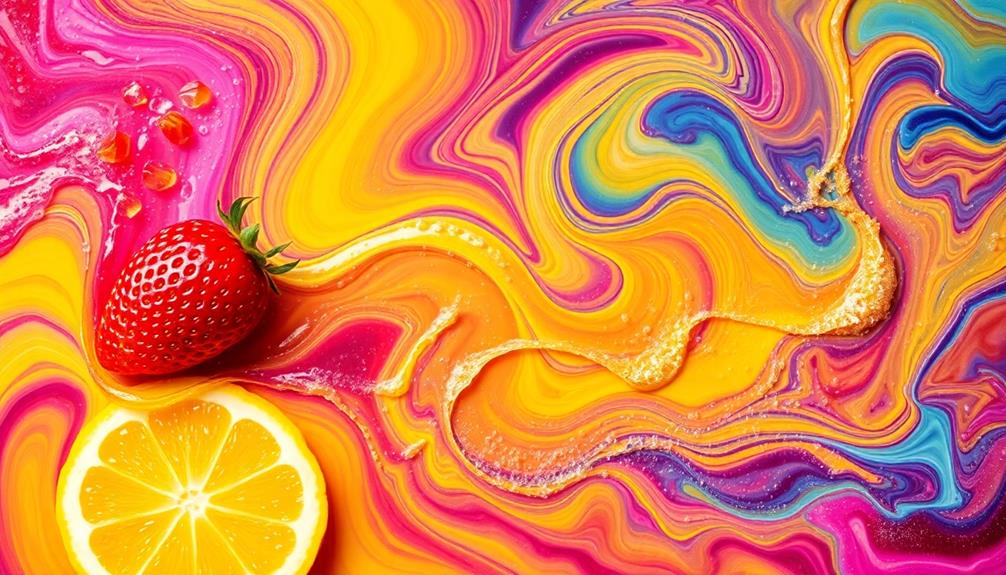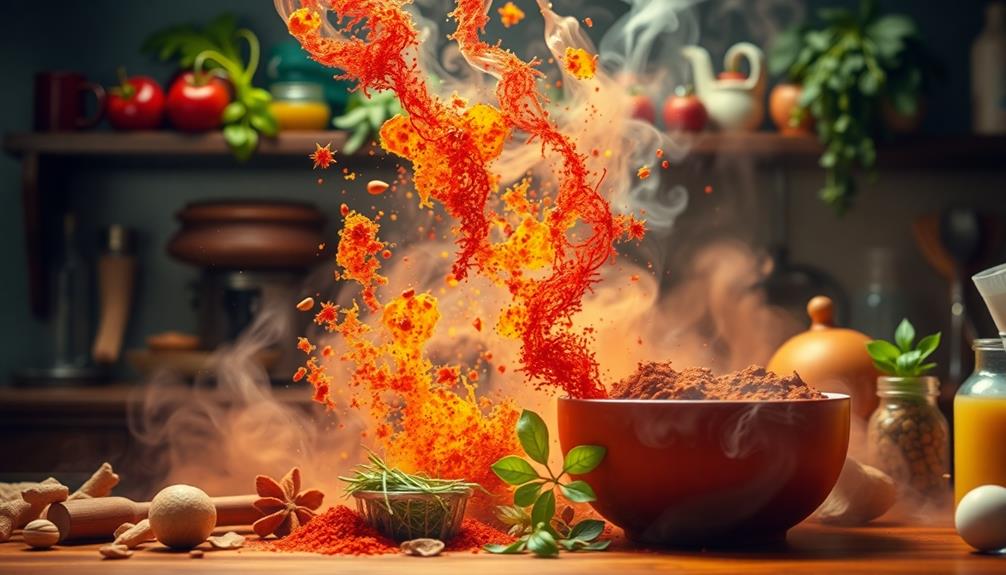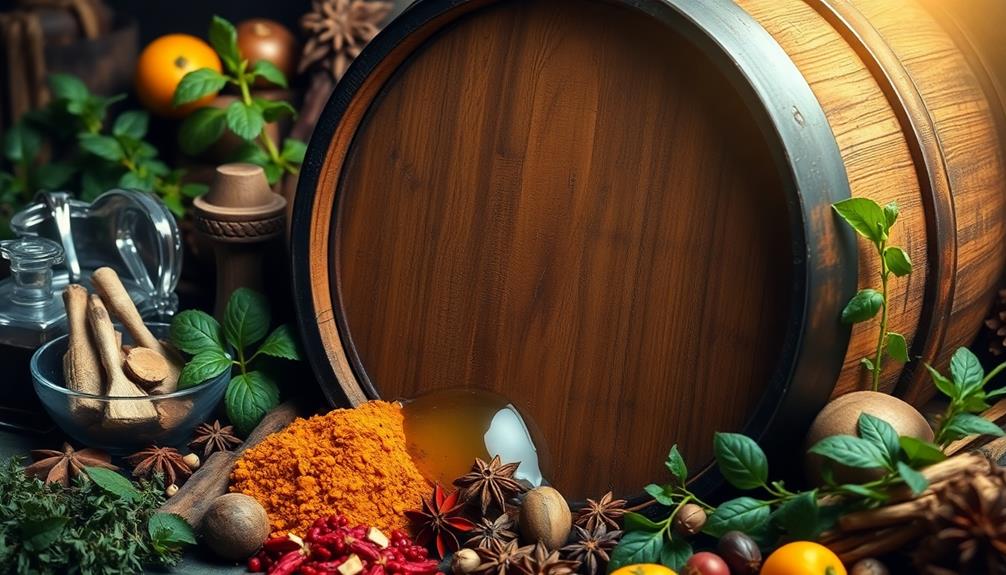Synesthesia intertwines your senses, making flavor perception uniquely fascinating. If you have lexical-gustatory synesthesia, certain words can evoke distinct tastes, enhancing or altering how you experience food. Colors can also play a role; for instance, yellow might remind you of citrus while green could evoke freshness. This condition affects about 4% of the population and is influenced by both genetic and environmental factors. Those with synesthesia might enjoy food differently, leading to creative culinary experiences. Curious about how these connections might affect your next meal? There's more to explore about this intriguing sensory phenomenon.
Key Takeaways
- Synesthesia intertwines senses, allowing individuals to experience distinct flavors linked to specific words or colors, enhancing culinary enjoyment.
- Color associations significantly influence flavor perception, with yellow evoking citrus and red suggesting sweetness.
- Lexical-gustatory synesthesia connects language to taste, affecting food preferences and overall dining experiences.
- Genetic predispositions and environmental factors contribute to the occurrence of synesthesia, impacting how flavors are perceived.
- Understanding synesthesia can inform food marketing and culinary creativity, enhancing how dishes are presented and enjoyed.
Understanding Synesthesia

Understanding synesthesia involves exploring a fascinating neurological condition where your senses intertwine in unexpected ways. This condition triggers involuntary cross-sensory experiences, meaning that stimulation of one sensory modality can lead to automatic sensations in another. For instance, you might see colors when you hear sounds.
Among the over 65 documented forms of synesthesia, grapheme-color synesthesia is the most common. People with this form associate specific colors with letters or numbers, creating a unique visual experience. Notably, flavor perception might also be influenced by this condition; for example, someone with lexical-gustatory synesthesia may taste Mushroom Masala when they hear certain words.
On the other hand, lexical-gustatory synesthesia is a rarer type, linking particular words or sounds to distinct tastes. If you have this form, hearing certain words could evoke specific flavors, influencing your flavor perception.
The prevalence of synesthesia is estimated to affect around 4% of the population, suggesting that approximately 307 million individuals worldwide experience these intriguing sensations.
Research shows that synesthetic experiences can also impact how you perceive flavors in food, causing potential misinterpretations of actual tastes when your sensory associations come into play. Understanding this condition can deepen your appreciation for the complexity of human perception and its effects on everyday experiences.
Types of Flavor Perception

Flavor perception isn't just about taste; it involves a complex interplay of senses that shapes your overall experience of food. Your taste experience is influenced not only by gustatory stimuli but also by color associations and contextual factors. For instance, specific colors can evoke certain flavors in your mind, greatly altering your perception of what you're tasting.
| Color | Associated Flavor | Impact on Perception |
|---|---|---|
| Yellow | Citrus | Enhances freshness and tanginess |
| Red | Sweetness | Increases the expectation of sweetness |
| Green | Freshness | Suggests healthiness and crispness |
| Blue | Unusual flavors | Can evoke curiosity and novelty |
Moreover, lexical-gustatory synesthesia demonstrates how language can trigger distinct flavor perceptions. For those with this rare condition, hearing certain words might conjure specific tastes, intertwining the domains of verbal and sensory experiences. The visual cortex plays a crucial role here, showcasing how visual cues impact flavor perception. Ultimately, your taste experience is shaped by a rich tapestry of sensory inputs, making each bite a unique adventure.
Genetic and Environmental Factors

Synesthesia isn't just a quirk of perception; it's influenced by both genetic and environmental factors. Research shows there's a genetic component to synesthesia, with familial occurrence suggesting that if someone in your family experiences it, your chances increase considerably.
Studies have identified specific chromosomal regions associated with synesthesia, often linked to conditions like autism and dyslexia. This connection highlights the complexity of synesthetic experiences. Additionally, the way we perceive flavors can be influenced by cultural contexts, such as the unique tastes found in Ethiopian cuisine, which offers a diverse range of flavors that may enhance synesthetic associations.
However, genetics isn't the whole story. Environmental interactions play an essential role in shaping your synesthetic associations. When you're exposed to certain stimuli, such as sounds or colors, these experiences can intertwine with previously learned categories, enhancing your flavor perception.
This means that your unique environment can contribute to how you perceive flavors in a synesthetic way.
The prevalence of synesthesia varies widely. While earlier estimates suggested it affected about 1 in 25,000 individuals, more recent studies indicate that around 4.4% of the population may experience it.
This variability further emphasizes the significance of both genetic predispositions and environmental influences in the development of synesthesia, making it a fascinating area of research.
Impact on Culinary Experiences

The interplay between genetic and environmental factors shapes not only how synesthetes perceive the world but also how they experience food. For those with lexical-gustatory synesthesia, specific words or sounds can evoke distinct tastes. Imagine hearing the name "Tony" and tasting macaroni—it's a unique twist on culinary preferences that influences what you enjoy.
This phenomenon may be particularly fascinating when considering dishes like Red-Braised Pork Belly, where the rich flavors could evoke different sensory experiences. However, this perception can lead to confusion; the visual presentation of food might alter your flavor experience, making you misinterpret a dish's taste based on its appearance.
Synesthetic experiences can spark culinary creativity, encouraging you to experiment with flavors and presentations that create multisensory associations. This innovation can lead to exciting, creative dishes that tantalize the palate.
Yet, social dining may pose challenges, as the colors of plates or the arrangement of food might disrupt your enjoyment and skew your taste perceptions.
Understanding the impact of synesthesia on flavor perception informs food marketing strategies, helping to enhance consumer experiences. By recognizing these sensory influences, culinary professionals can develop dishes and presentations that resonate with synesthetes, ultimately enriching the dining experience for everyone.
Future Research Directions

Exploring the intersection of color and taste perception offers an exciting avenue for future research. You'll want to investigate how emotional factors shape color and flavor associations, as they notably impact sensory experiences. Understanding these emotional mediators can deepen insights into the multisensory interactions that influence taste perception.
Another promising direction is the application of Bayesian causal inference, which could enhance predictive models regarding how color influences flavor. This approach allows for a more nuanced understanding of the intricate relationships at play. Developing detailed models that integrate psychological and neurological perspectives alongside sensory design will be essential in explaining these complexities.
Additionally, empirical studies validating theoretical frameworks on color-flavor relationships are vital for advancing knowledge in this area. Such research can inform practical applications in culinary contexts, transforming how you think about food presentation and enjoyment.
Interdisciplinary approaches that combine psychology, neuroscience, and sensory design will further enrich this field, addressing challenges and enhancing our understanding of multisensory flavor perception. By pursuing these research directions, you'll contribute to a more profound comprehension of how we experience flavor in a colorful world.
Frequently Asked Questions
How Is Synesthesia Related to Perception?
Synesthesia intertwines your sensory experiences, making you perceive one sense through another. When you hear sounds or see colors, you might taste flavors simultaneously, enhancing your overall perception and enriching your sensory world in unique ways.
Does Synesthesia Affect Taste?
Synesthesia's like a painter's palette, blending senses in unexpected ways. It affects taste by intertwining words and flavors, making you perceive tastes that aren't actually there—sometimes leading to delightful surprises or confusing misinterpretations.
What Is Synthesia but With Taste?
Synesthesia with taste means you experience flavors when hearing certain words or sounds. For you, a name might evoke the taste of chocolate, blending senses in a unique way that influences how you perceive food.
Which Type of Synesthesia Allows People to Taste Words?
Imagine a world where words dance on your tongue like vibrant flavors. In lexical-gustatory synesthesia, you taste specific words, experiencing rich, unexpected sensations that blur the lines between language and your culinary adventures.
Conclusion
In the wild world of flavor perception, synesthesia isn't just a quirky side note—it's a dazzling gateway to a universe where each bite explodes with vibrant colors and melodious sounds! Imagine tasting a symphony or savoring a sunset; that's the magic of synesthesia in our culinary experiences. As we dive deeper into this connection, we might just reveal the secret recipes of the universe, turning every meal into an unforgettable masterpiece. Who knew food could be this extraordinary?










